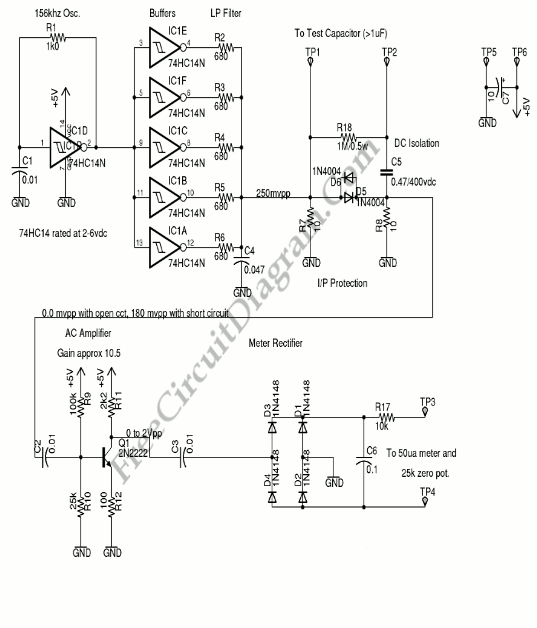ESR (Equivalent Series Resistance Meter) Using 74HC14

ESR is Equivalent Series Resistance. ESR is one of the characteristics that defines the performance of an electrolytic capacitor. It’s highly desirable to use Low ESR in capacitor as any ripple current through the capacitor causes the capacitor to heat up due to the resistive loses. By drying out the electrolyte at an ever increasing rate, the heating accelerates the demise of the capacitor. Over the lifetime of a capacitor, Its not common to increase the ESR by factor of 10 to 30 times or even go open circuit. 2000-15000are electrolytics typical lifetime rating, and very dependent on ambient operating temperature. The filtering operation of the capacitor becomes impaired and eventually the circuit fails to operate correctly as the ESR increases.

For component designations see the schematic. Using gate of 74hc14, the circuit starts with a 150KHz oscillator. To increase the current drive to the low pass filter, the rest of the gates are used as buffers. Because the square wave signal contains a lot of energy in high frequency odd order harmonics, the single pole low pass filter is necessary. The low impedance drive signal to the test capacitor is provided by the output of the filter which is applied across a 10ohm load resistor. The circuit are protected by diodes D5 and D6 from discharge spikes if you happen to test a charged capacitor. To discharge C5, we can use R18 so that you don’t blow up anything if you alternately test charged high and low voltage caps. C5 isolates the test circuit from DC voltages up to 400 volts.
By shorting the test leads together and adjusting the pot in the meter circuit for a full scale ( 0 ohms )reading on the meter, the meter is zeroed. We can verify the proper operation of the circuit by checking several values of resistor with the meter. Shorted leads should indicate full scale, a 1 ohm resistor should read about 90% of full scale, a 10 ohm resistor should read about 40% of full scale and a 47 ohm resistor should barely move the needle to about 10% of FSD. The absolute readings will vary with battery voltage and temperature, but the idea is that most ESR values should be much less than 10 ohms. It’s means good caps test at very close to full scale and bad caps test at little or no deflection. [Source: Glaister Consulting]